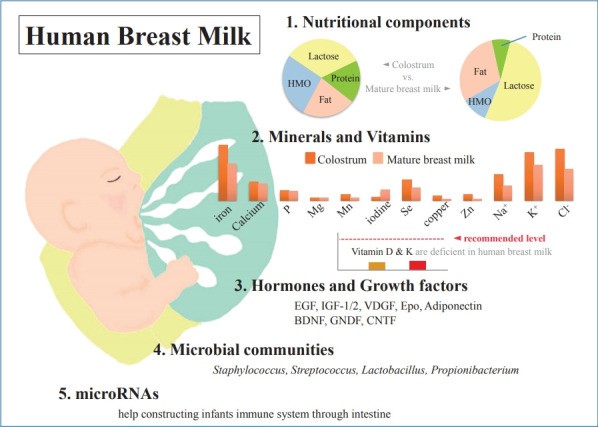Breast milk is widely recognized as the gold standard for infant nutrition. It provides a complex blend of nutrients, antibodies, and beneficial microbes tailored to support a baby’s growth and development. Among these essential nutrients, protein plays a crucial role. But How Much Protein Is There In Breast Milk? This article will explore the protein content of breast milk, its variations, and its importance for infants.
Breast milk is essential for an infant’s growth, offering an irreplaceable source of nutrition and immunological support. While infant formulas strive to mimic breast milk, they can’t replicate its complexity. Recent research continues to uncover the diverse components of breast milk and their specific roles in infant health. This article will delve into the amount of protein in breast milk and its impact on the developing baby.
Protein Content in Breast Milk: An Overview
Human breast milk (HBM) is composed of roughly 87-88% water and 12-14 g/L of solid components, with macronutrients comprising about 7% carbohydrates (60-70 g/L), 1% protein (8-10 g/L), and 3.8% fat (35-40 g/L). The amount of protein in breast milk isn’t static; it changes based on several factors.
 Breast milk composition graphic file
Breast milk composition graphic file
Here’s a more detailed breakdown:
1. Variations in Protein Levels
The protein concentration in breast milk varies depending on several factors including:
- Stage of Lactation: Colostrum, the milk produced in the first few days after birth, is richer in protein than mature milk.
- Time of Day: There can be slight variations in protein content throughout the day.
- Maternal Diet: While the overall protein content isn’t dramatically affected by maternal diet, the types of proteins and amino acids can be.
- Infant’s Age: Protein levels tend to decrease slightly as the baby grows older.
- Prematurity: Breast milk produced for preterm infants often has a higher protein content.
2. Colostrum vs. Mature Milk
Colostrum, the early milk, is particularly high in protein, around 14-16 g/L, which gradually decreases to 8-10 g/L in mature milk (after 3-4 months) and further to 7-8 g/L after 6 months. This higher protein content in colostrum is critical for providing the newborn with essential antibodies and supporting their developing immune system.
The high protein content in colostrum, especially immunoglobulins like IgA and lactoferrin, helps protect newborns from infections. As lactation progresses to mature milk, the protein content adjusts to meet the infant’s changing needs.
3. Whey vs. Casein
Breast milk protein is a mix of whey and casein proteins. Whey proteins are easier to digest, while casein forms curds in the stomach. The ratio of whey to casein changes over time. Colostrum has a whey/casein ratio of approximately 90:10, which shifts to 60:40 in mature milk. This high whey content in early breast milk aids in easier digestion for the newborn.
Types of Protein in Breast Milk and Their Functions
Breast milk contains various proteins, each with unique functions:
1. Whey Proteins
Key whey proteins include:
- Alpha-lactalbumin: Aids in lactose synthesis and provides essential amino acids.
- Lactoferrin: Binds iron, inhibiting bacterial growth and boosting the immune system.
- Immunoglobulin A (IgA): Protects the intestinal mucosa and fights bacteria.
Alpha-lactalbumin is particularly abundant, comprising 40% of whey protein. Lactoferrin and lysozyme offer antibacterial protection, while IgA shields the intestinal lining.
2. Casein Proteins
Casein proteins in breast milk are more easily digested than those in cow’s milk, forming softer curds that are gentle on the infant’s digestive system. These proteins help regulate intestinal motility and aid in calcium absorption.
3. Other Proteins
Breast milk also contains non-protein nitrogen, which accounts for a significant portion of the total nitrogen content. This nitrogen is used to synthesize non-essential amino acids, contributing to the infant’s overall growth and development.
Why is Protein in Breast Milk Important?
Protein is vital for many reasons:
- Growth and Development: Essential for building and repairing tissues.
- Immune Function: Antibodies and immune factors protect against infections.
- Enzyme Production: Proteins act as enzymes, facilitating biochemical reactions.
- Nutrient Transport: Helps transport nutrients throughout the body.
Protein’s essential amino acids support tissue growth, immune response, and overall development. Adequate protein intake ensures infants meet key developmental milestones.
Impact of Maternal Diet and Other Factors
While the total protein content in breast milk is relatively stable, certain factors can influence its composition:
- Maternal Health: Maternal health conditions can affect protein composition.
- Environmental Factors: Environmental exposures may also play a role.
- Dietary Intake: Adequate protein and essential nutrients in the mother’s diet support optimal milk production.
Maintaining a balanced diet is crucial for lactating mothers, ensuring breast milk contains all the necessary nutrients for the baby’s growth. Mothers should focus on protein-rich foods and a variety of fruits and vegetables to support milk quality.
Breast Milk vs. Infant Formula
Infant formulas attempt to mimic breast milk but often fall short in replicating its complex composition. The whey-to-casein ratio and the types of proteins differ significantly. For instance, bovine milk has a higher casein content and lacks some of the unique whey proteins found in human milk.
While formulas can provide adequate nutrition, they lack the bioactive components and antibodies present in breast milk, which offer immunological benefits to the infant.
Addressing Concerns About Protein Intake
Some parents worry about whether their breastfed baby is getting enough protein. Here are a few key points:
- Growth Monitoring: Regular check-ups with a pediatrician can help monitor the baby’s growth and development.
- Signs of Adequate Intake: Weight gain, length increase, and head circumference growth are indicators of adequate protein intake.
- Addressing Deficiencies: In rare cases of deficiency, healthcare providers can offer guidance on supplementation or dietary changes.
Routine pediatric visits are essential for tracking growth and ensuring proper nutrition. Parents should address any concerns about their baby’s development with healthcare professionals to identify and manage potential issues.
The Role of Hormones and Growth Factors
Breast milk contains hormones and growth factors that are critical for infant development:
- Epidermal Growth Factor (EGF): Supports intestinal maturation and repair.
- Insulin-like Growth Factor (IGF): Promotes erythropoiesis and protects against intestinal damage.
- Vascular Endothelial Growth Factor (VEGF): Regulates angiogenesis and reduces retinopathy risk in preterm infants.
These growth factors influence various systems, including the intestinal tract, vasculature, and nervous system, ensuring optimal development.
Microbiome and MicroRNAs in Breast Milk
Emerging research highlights the presence of beneficial microbes and microRNAs in breast milk, contributing to the infant’s gut health and immune development:
- Microbiome: Beneficial bacteria in breast milk help colonize the infant’s gut, supporting immune function.
- MicroRNAs (miRNAs): These molecules play a role in gene regulation, immunoprotection, and developmental programming.
These components are thought to be transported to the infant’s intestine through lactation, remaining intact and absorbed by intestinal epithelial cells, supporting various functions, such as immunoprotection and developmental programming.
Conclusion
So, how much protein is there in breast milk? The protein content in breast milk is carefully calibrated to meet the evolving needs of a growing infant, with colostrum providing a protein-rich start and mature milk offering a balanced blend of whey and casein. While the exact amount varies, the benefits of breast milk protein are undeniable, contributing to growth, immunity, and overall health. Breastfeeding remains the optimal choice for infant nutrition, providing a dynamic and irreplaceable source of essential nutrients.

